There is considerable interest in revolvers that fire semi-automatic pistol cartridges these days. Take the new Ruger Match Champion 10mm as just one and then look back one hundred years ago to revolvers such as the S&W and Colt 1917 .45 ACP revolvers to prove the concept of ammunition consolidation. The old Smiths and Colts were made to chamber .45 ACP cartridges because the military couldn’t get 1911 pistols made fast enough. So it made more sense to get revolvers produced that could fire the military’s huge depots full of .45 handgun ammo.
Consolidation of ammunition applies to those with only a few firearms as well as to those with a collection numbering in the multiple dozens or more. In the old west, the .44-40 was popular because it was chambered in lever action rifles and in single action revolvers. The same ammo for both made sense when travel across wide open spaces was measured in weeks on horseback instead of hours in an jet plane. For those with only two guns, it sure made sense to need only one shared caliber.
Some of us with lots of firearms in our safe may have found ourselves shying away from certain guns because “I really just don’t want to get involved in another caliber.” I remember when the .40 S&W, .357 Sig, the .41 AE, and even the 10mm first came out. While all were very intriguing, the idea of buying yet another handgun cartridge caused me consternation.
The Charter Arms Pitbull double action revolver was initially introduced in 2012. It was chambered for the .40 S&W cartridge, which was an interesting choice. Charter Arms’ intention was obviously for this revolver to be a police officer’s backup gun. The .40 was still a popular police pistol cartridge back eight years ago. Nine millimeter and .45 ACP versions of the Pitbull have subsequently been released. The 9mm version was of interest to me since relatively inexpensive 9mm ammo is common these days. Nine millimeter is often found on retail mass-market store’s shelves for under $10 per box of 50 rounds. That’s pretty cheap for factory centerfire ammo.
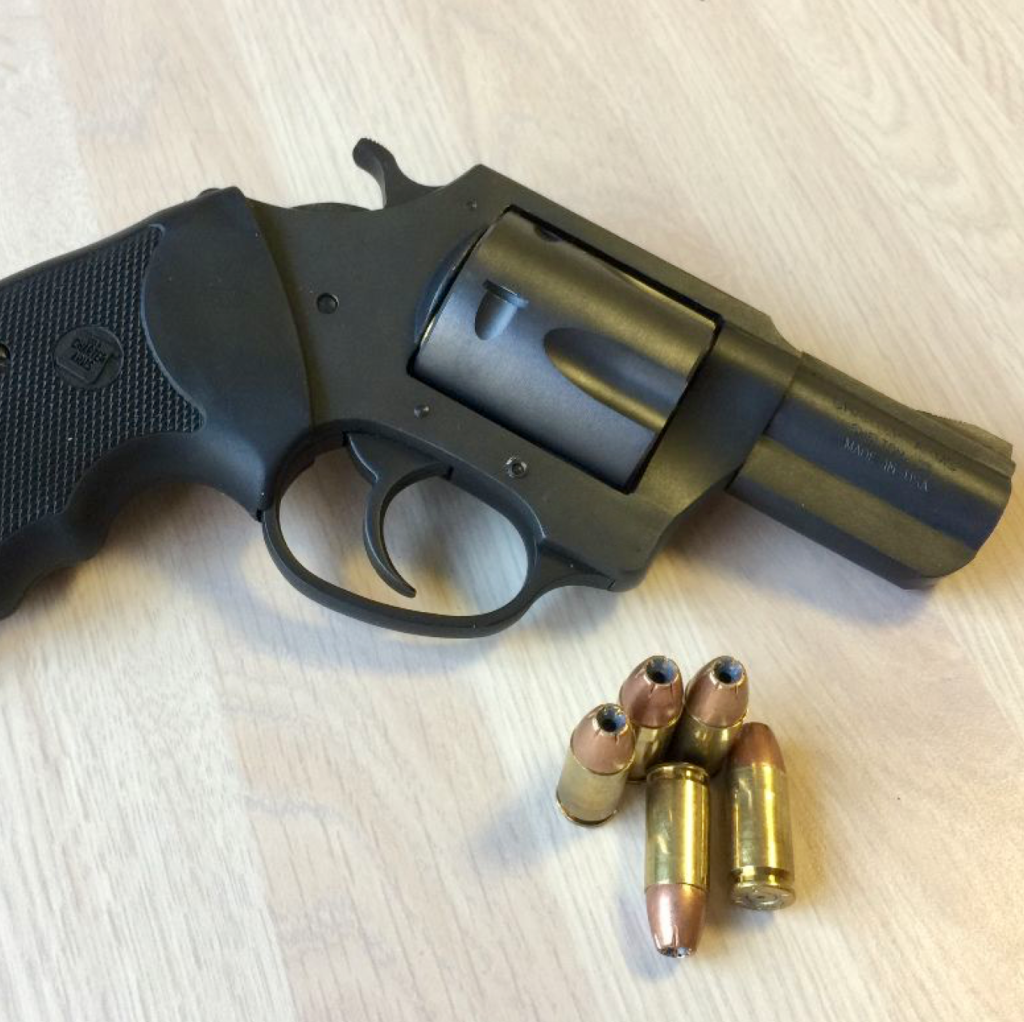
It goes without saying that RevolverGuys like revolvers and I like ‘em all. Single actions, double actions, Colt, Ruger, S&W, big Magnums, little snub noses. I’d like to own a Korth or a Manurhin if they weren’t so darn expensive. I do own a Freedom Arms single action, but I had to sell a couple other guns to be able to afford it. I also like classic revolvers for their “old world” quality and value. I like certain lesser sought after brands too, when they offer features the big names don’t.
Revolver Guys almost can’t help but become a little bit snobbish about the quality guns we’re used to. We may forget that some people can only afford just a few guns or maybe even just one. We are also used to the feel of S&W or Ruger or Colt double action triggers. In my opinion, the S&W double action feels the best in my hands when I’m firing double action with an untouched factory trigger.
Charter Arms Pitbull 9mm
Charter Arms has been around since 1964 and their .38 Undercover and .44 Special Bulldog have been used as police backup and off-duty guns for more than 50 years. The five-shot Bulldog .44 has a certain mystique all its own. I worked with a cop who carried one as a backup his entire career and he still carries it now that he’s retired. The Bulldog’s recoil impulse is massive with hot .44 Special ammo, but then most snub nose revolvers provide a wallop to your palm. Every person I’ve ever met who owned a .44 Bulldog loved it.
I had already spent some time with the .40 caliber Charter Arms Pitbull back in 2012 when it first came out. It was uncomfortable to shoot, to say the least. The .40 S&W kicks like the proverbial mule when fired in that little five-shooter. It’s right up there with shooting hot .357 Magnum rounds in a five shot snubby. Today my interest is in the 9mm Pitbull and Charter Arms offers a new Blacknitride+™ finish that warranted inquiry as well.
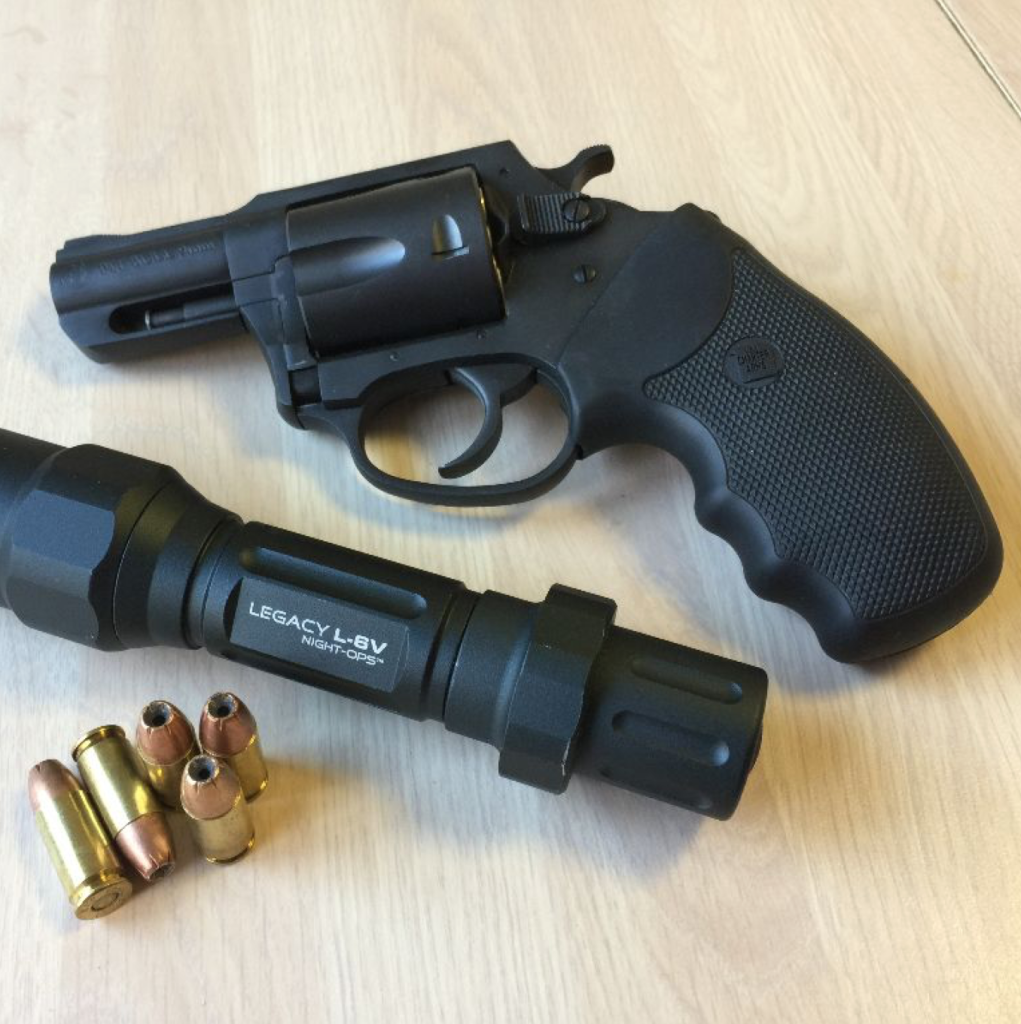
Unique Spring Loaded Extractors
Revolvers utilize their cartridges’ rear rim to keep each round properly fixed in each cylinder chamber. Moon clips (flat metal stampings usually made to hold 2, 3, or 5/6 rounds – and referred to as third/half/full moon clips) were invented to help chamber .45 ACP semi-auto rounds in the Colt and S&W 1917 revolvers made for US military use. The advantage of full moon clips is that they serve as speedloaders by allowing quick insertion of an entire cylinder full of ammo. They also help extract all the rounds at the same time with a quick push of the ejector rod. But moon clips are delicate and can be ruined when inserting cartridges into them or prying empty cases out.
Some revolvers can fire semi-auto cartridges without moon clips and their empties are simply pushed out from the front of the cylinder with a pencil type object. Moon clips are best handled with a loading tool and a “de-mooner” specifically for removing empty cases from these snowflake shaped pieces of spring steel. Without a tool, moonclips are likely to become bent and put out of commission and once they’re bent, there’s almost no bending them back. The good part is that they’re inexpensive and you can buy a bunch of them.
Charter Arms came up with spring-loaded extractors in each cylinder chamber of the Pitbull. 9mm cartridges load just like standard revolver cartridges in this distinctive handgun, just push then into each chamber one or two at a time. You have to overcome the slight pressure of the tiny little springs, so a little push is needed, they won’t just drop into the chambers. But the Pitbull loads pretty much the same as every other standard double action revolver chambered for rimmed revolver cartridges.
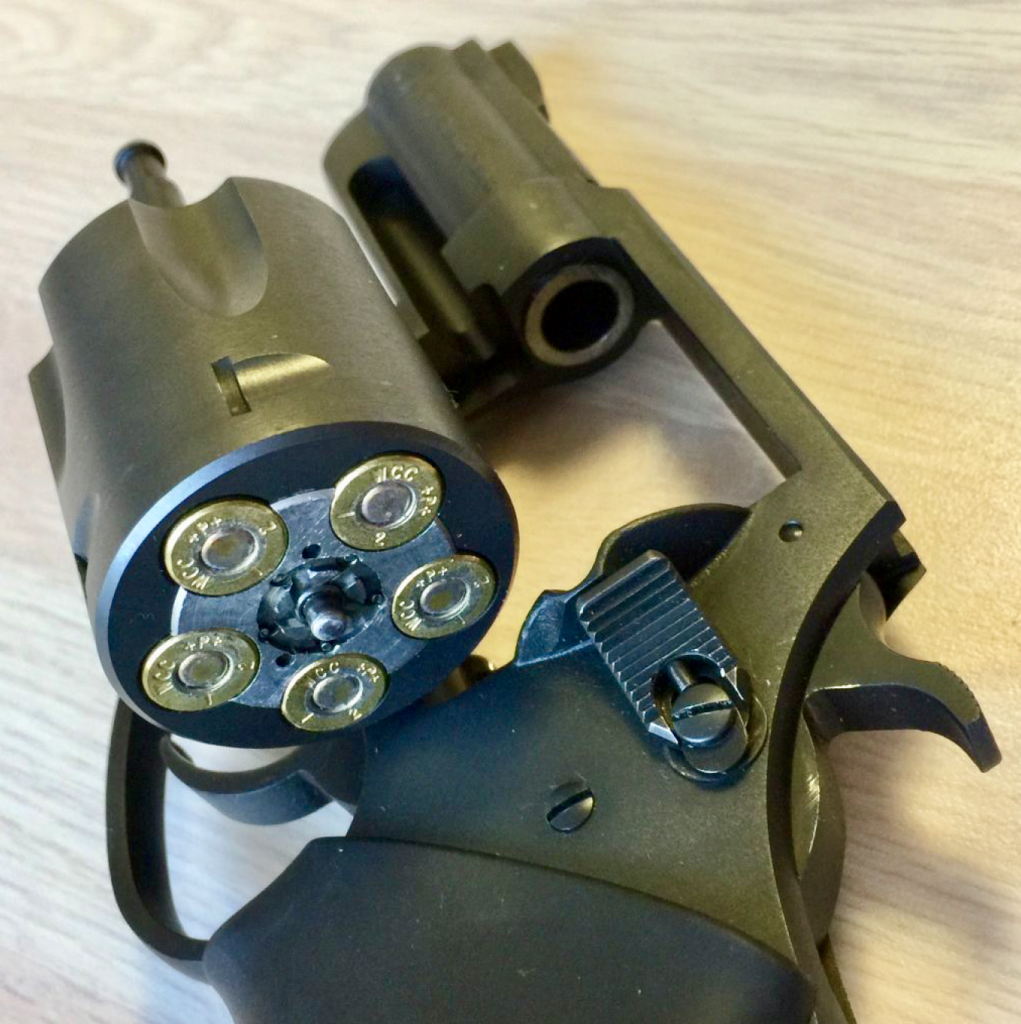
There aren’t any speedloaders available for the Pitbull, but Tuff Products offers six and eight round QuickStrips for 9mm rounds. These flexible rubberized devices hold ammunition in strips that carry flat in your pockets. Packing extra ammo with QuickStrips is the way to go.
Ejecting empty cases is performed the same as you’re used to with other double action revolvers. The Pitbull’s cylinder release latch is pushed forward, in similar fashion as those from S&W. The Charter Arms revolvers’ latch actually slips under the left side recoil shield. You have to push it all the way forward and your eyes tell you it’s too close to the shield. But just work it hard and it will be fine. The five-shot cylinder swings out and the ejector rod has a flat section that spreads out some of the force over your thumb when you press it. Ejection is positive and all empty cases fell out consistently when the muzzle was pointed straight upward (even after firing 150 rounds). Empties clear the slightly recessed area of the hard rubber, finger grooved grips.
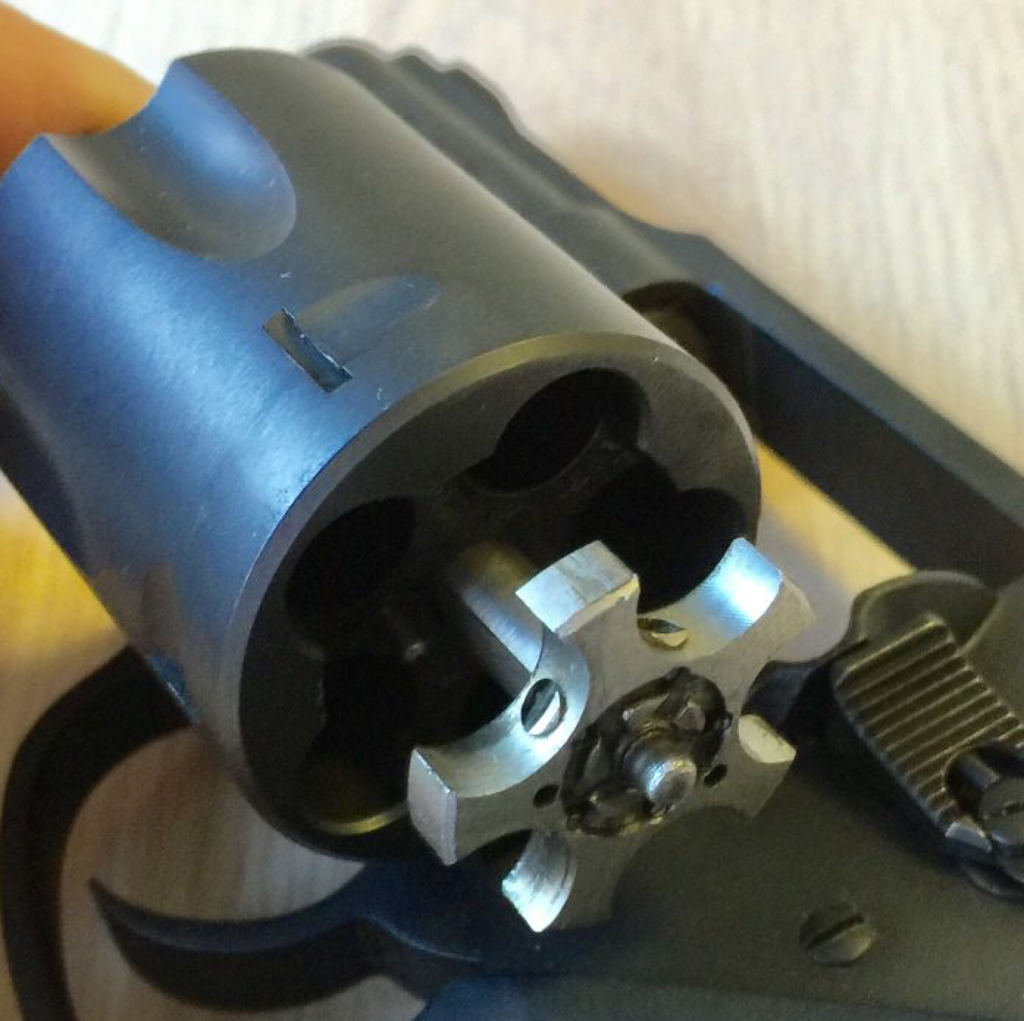
The ejector felt a bit sticky from slight friction when I received the new Pitbull. I cleaned the gun with solvent and then oiled the ejector slightly before pressing it a few hundred times to see if that helped. The friction evaporated and it became much smoother in operation. The Pitbull’s 2.2-inch barrel is machined with an underlug that protects the ejector rod when the cylinder is closed and the rod is nestled up under the barrel.
Blacknitride+™ Finish
Charter Arms offers a matte black finish called Blacknitride+™ from a company named H&M. NASA uses this process, as do NASCAR race teams and oil drilling rigs. The process permeates the metal and is actually a case hardening process that will not wear off since it goes beyond the firearm’s surface. The Pitbull 9mm exhibited a slightly lighter shade of black, with a smooth finish that was pleasing to the eye. The inside of the barrel and cylinder is processed in Blacknitride+™ as well and claims to improve performance and ease of cleaning.
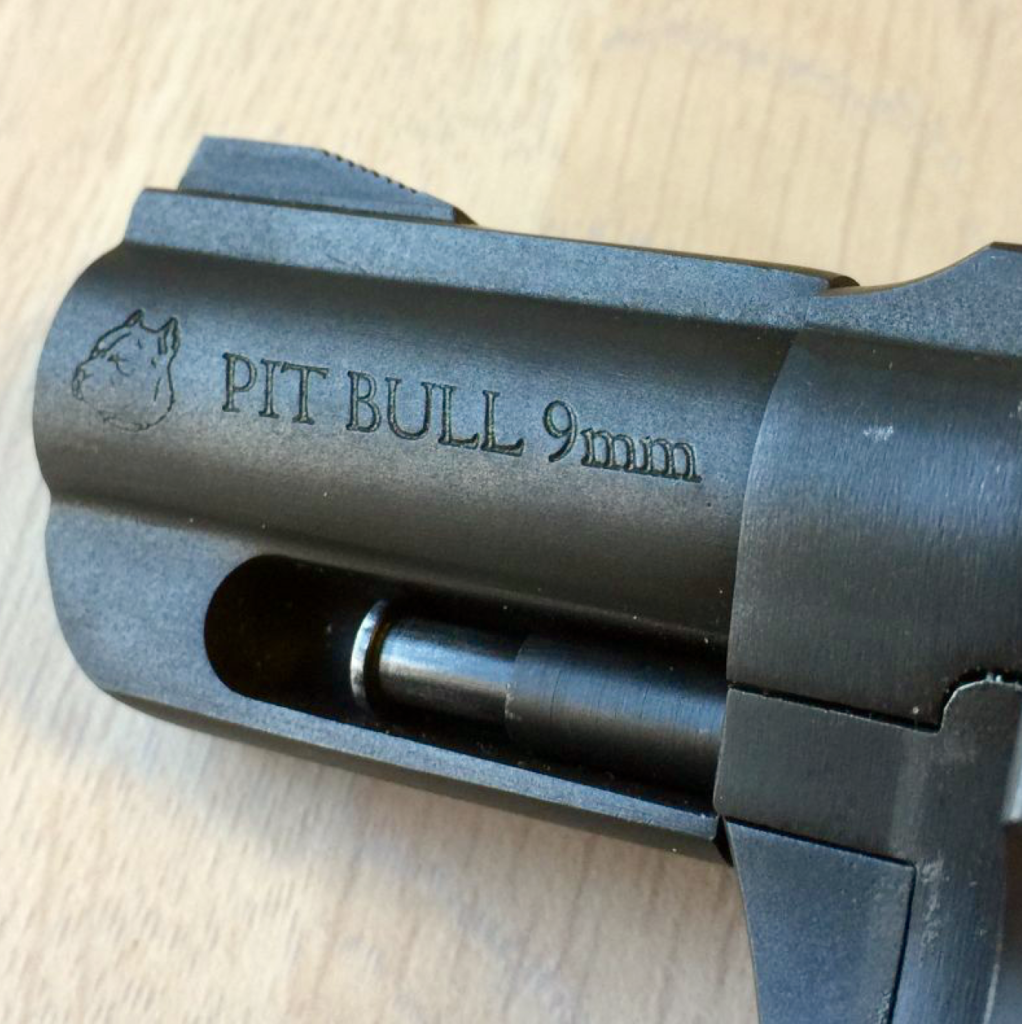
The Pitbull is made from stainless steel and weights 22 ounces empty. It’s not a super lightweight snubby, nor is it too heavy for pocket carry. The front sight is wide and serrated and snag free. The rear sight is a deep channel along the top of the frame that provides a wide notch to line up with the front sight. The hammer is serrated for single action use and is abbreviated with a curl that allows quick thumb cocking. The front of the trigger is serrated too, but not to the point where it abrades your index finger when pulling the trigger.
The double action trigger weight was not measureable, which means it is somewhere over the 12 pound limit of my Lyman digital trigger gauge. With the revolver triple checked that it was unloaded, I pulled the trigger double action, dry firing it about three hundred times. I kept my off hand’s thumb on the hammer to prevent it from snapping forward hard each time and this poor man’s action job smoothed out the new gun’s trigger pull compared to how it came out of the box. It’s a good trigger pull, but not super smooth.
As the trigger is pulled double action, the cylinder rotates clockwise and the hammer comes back. The transfer bar raises up between the hammer and the frame mounted bronze firing pin. The cylinder locks up into the bolt before the hammer falls. Again, it works fine but it’s not as smooth as the triggers on the big three makers’ guns. But does it really need to be? For a small, concealable revolver, how good does the trigger need to be to get the job done? Will it still hit where it needs to a distances we expect a snubby to perform?
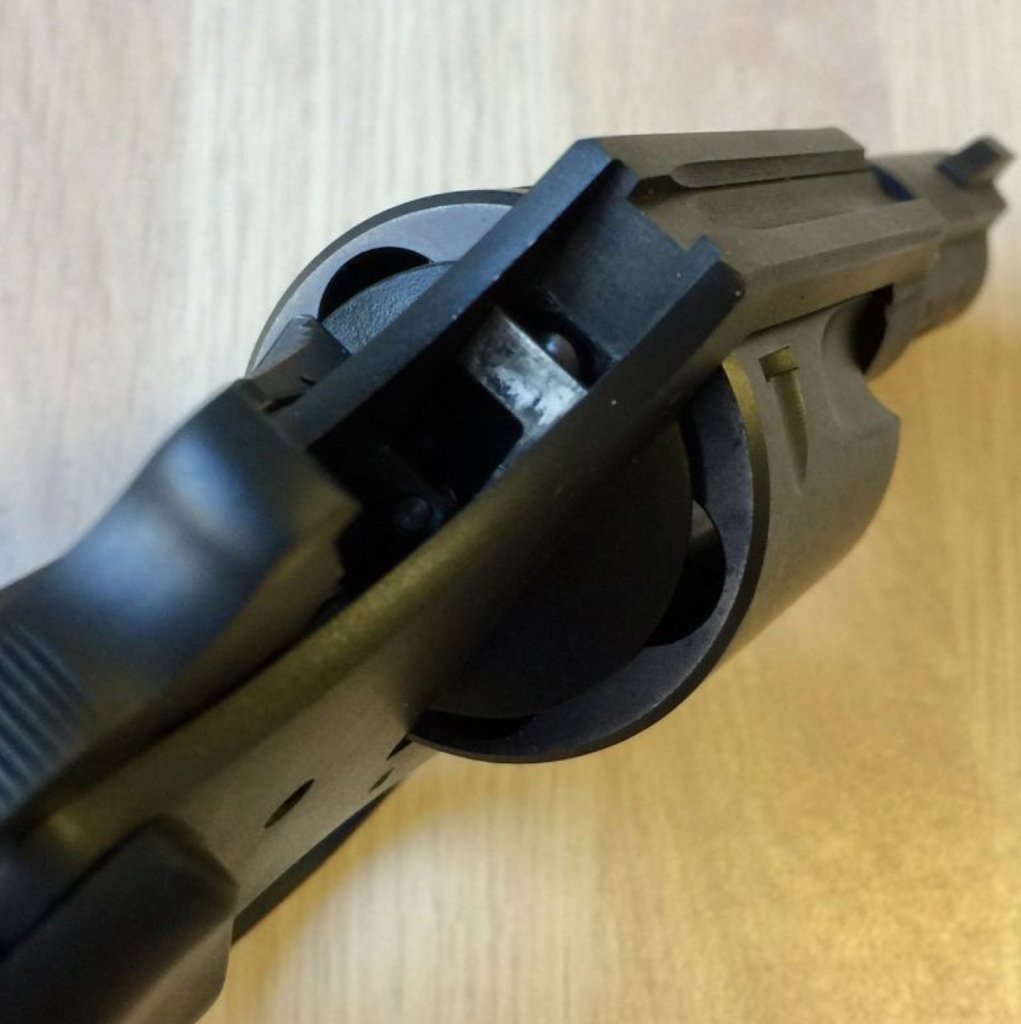
When the hammer was cocked and the trigger is pulled single action, it measured 3 pounds 6 ounces. When the trigger broke, it felt very precise and had no over travel.
At the Range
When I began my law enforcement career in 1988, my choices for duty carry caliber were .38 Special +P, 9mm, and .45 acp. That’s what my department stocked in the armory. I wanted a semi-automatic and the 9mm carry ammo of the day did not give me comfort. I chose the .45 for my first duty gun. Three decades later, my attitude toward 9mm ammunition has improved due to leaps in technology and advancements in engineering. I trust the 9mm more today than ever before. I also like it because it’s the least expensive of the popular centerfire calibers. So a revolver chambered in 9mm makes sense, especially if you have a semi-auto that already uses this round. You don’t have to buy another caliber and that’s not only sensible, but also fiscally responsible.
The big question was how would the Charter Arms Pitbull perform at the range? If you decide to consider this revolver for protection, you want to know how it will work under real world conditions. I prepared ten rounds of 9mm, five in the cylinder and five on the firing line countertop. I shot at a standard silhouette target stationed 21 feet away. Each shot was fired double action in a quick cadence that allowed reacquisition of the front sight, but the shots were not fired slow fire. After the fifth shot, I ejected the empty cases, reloaded, and fired another five shots.
The result was nine hits in the ten-ring and one shot just to the left in the nine-ring. Since I was focused on the Pitbull’s front sight, I’m not sure which round went in the nine-ring. All of my shots were a bit to the left and that was my fault and not the gun’s. I tend to pull a little to the left when firing a double action revolver.
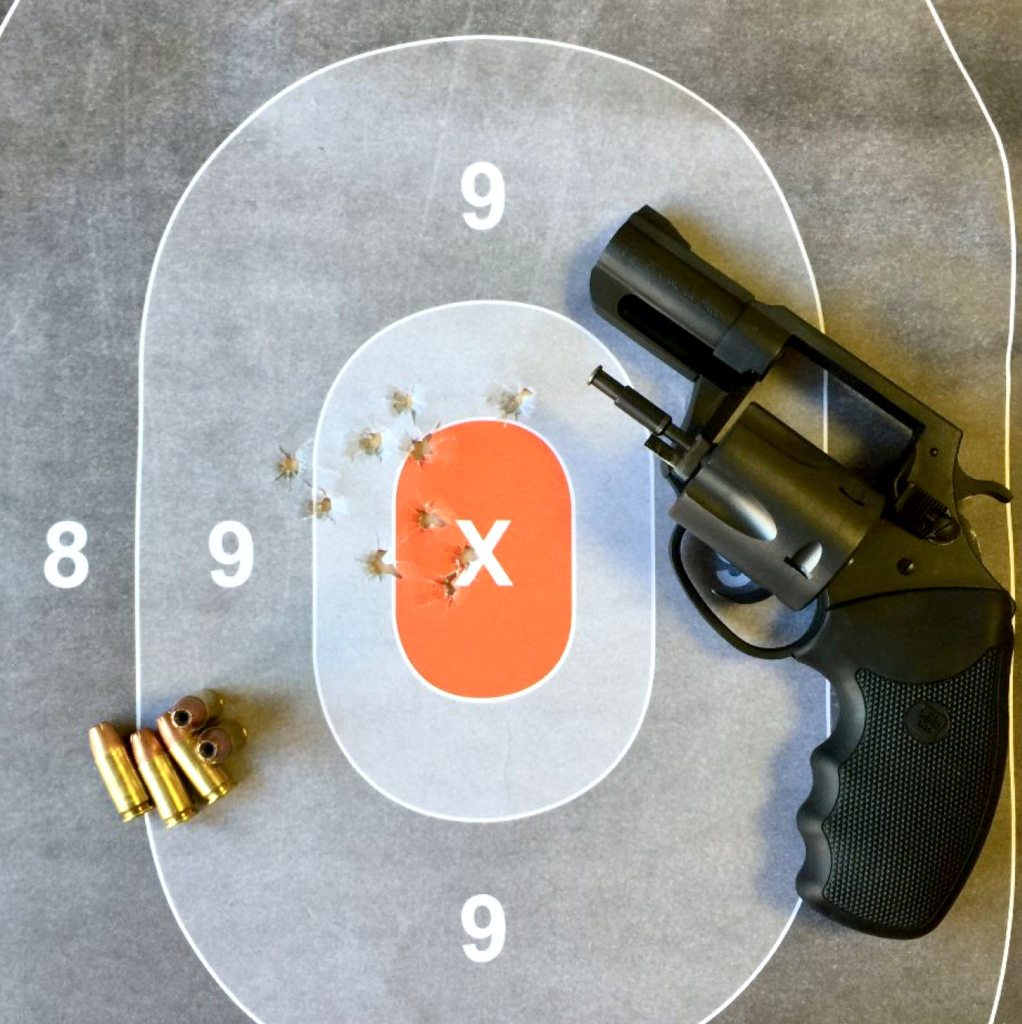
When it comes to reliability and accuracy of this 9mm revolver, the Charter Arms Pitbull’s performance was excellent. It fired 150 rounds of various bullet weights (115, 124, and 147 grain rounds) without fail. The sights work better than similar gun’s with tiny sights. The trigger works well and it certainly gets the job done, although it’s not silky smooth. Loading and unloading is similar to standard revolvers except for that little push you need to give each round when loading the cylinder. You can’t just drop the round in. You have to make it go in. Ejection cleared all five empties every time with the muzzle pointed skyward, letting gravity assist.
I’ve shot revolvers in competition and I’ve fired three matches at a time, with each match consisting of 50 rounds. Toward the end of the third match my revolver was getting fairly dirty. Inserting fresh cartridges and ejecting spent cases required more attention, which slowed things down. The Pitbull 9mm showed no signs of slowing down after 150 rounds. The 9mm cartridge seems to have a lot to do with this reliability as it burns clean in the cylinder.
Many shooters view the 9mm cartridge as a mild shooter. If you’re used to firing a .45 and then fire a 9mm in the same platform (1911, Glock, M&P, XDM, etc), you will notice considerably less recoil. However, the 9mm Parabellum is a rather hot round. It was designed to work the slide and overcome the recoil spring on semi-automatic pistols. When fired in a revolver there are no such mechanisms present to bleed off some of the 9mm’s energy. There’s just nowhere for that recoil to go except straight back into your palm, wrist, and arm.
The 9mm Charter Arms Pitbull is not a plinker. It’s feels very similar to firing .38 Special +P ammo in a 2-inch revolver. I wish the Pitbull’s grips were a bit softer so they could help tame some of the recoil. It should be noted that Charter Arms does not recommend +P 9mm ammo be fired in the Pitbull. Their claim is that you won’t gain much performance in a snub nose and the hotter rounds will cause quicker wear and tear. I did not fire +P loads and I would feel very comfortable carrying this Pitbull loaded with standard pressure 9mm hollowpoints.
Pitbull Gets the Job Done
Charter Arms offers the only 9mm revolver that doesn’t require moonclips or a pencil type device to punch out empty cases from its cylinder. The Pitbull chambers and fires and ejects 9mm semi-automatic cartridges just like standard revolvers. The tiny spring -loaded extractors in each cylinder chamber work well and the Pitbull was on target at 21 feet.
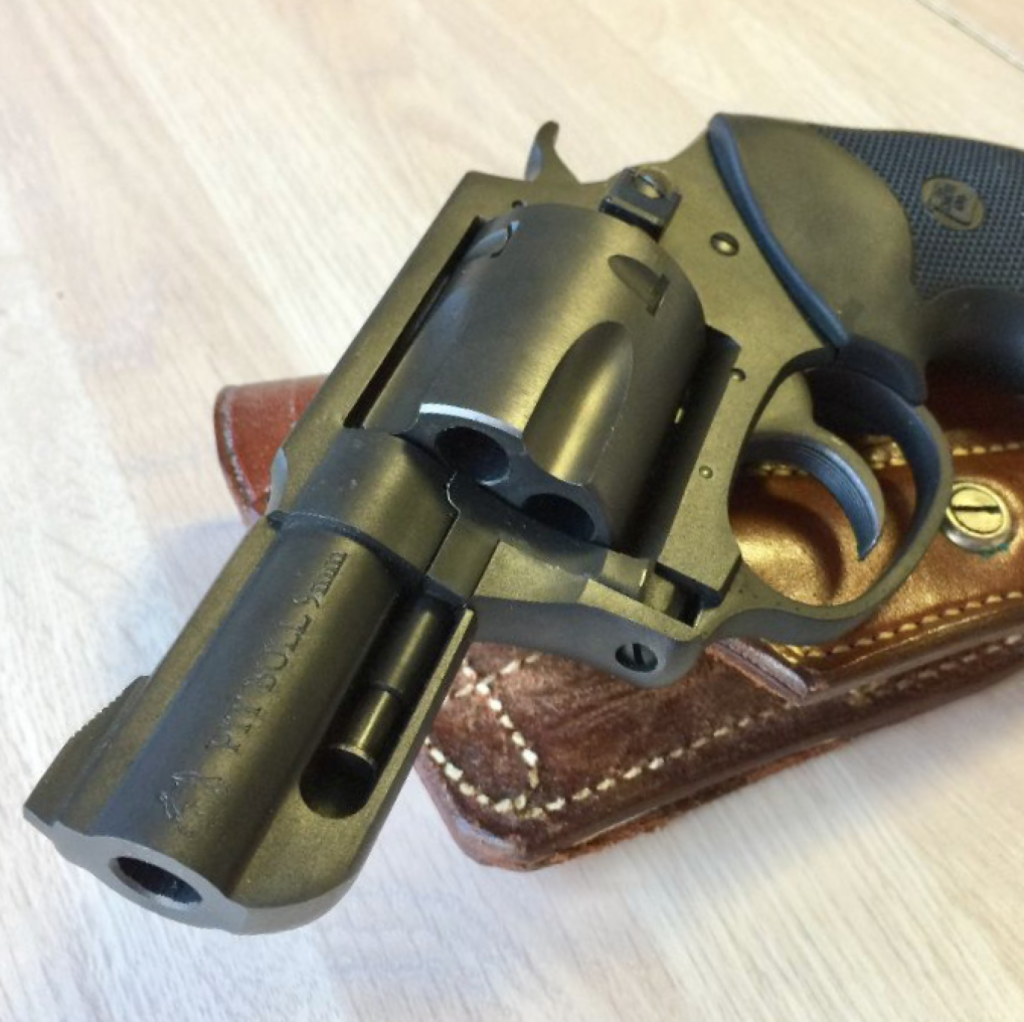
I wish the Pitbull kicked a little bit less, but I can’t change the laws of physics. Softer grips would help and Pachmayr and Crimson Trace (with a laser) make versions for the Charter Arms revolvers. The Pitbull should fit in most holsters made for S&W J-Frame or Colt Cobra/Detective Special holsters as long as they’re not specifically made for those guns. I have an old Clark leather hip holster for a Model 36 and the Pitbull fits its perfectly.
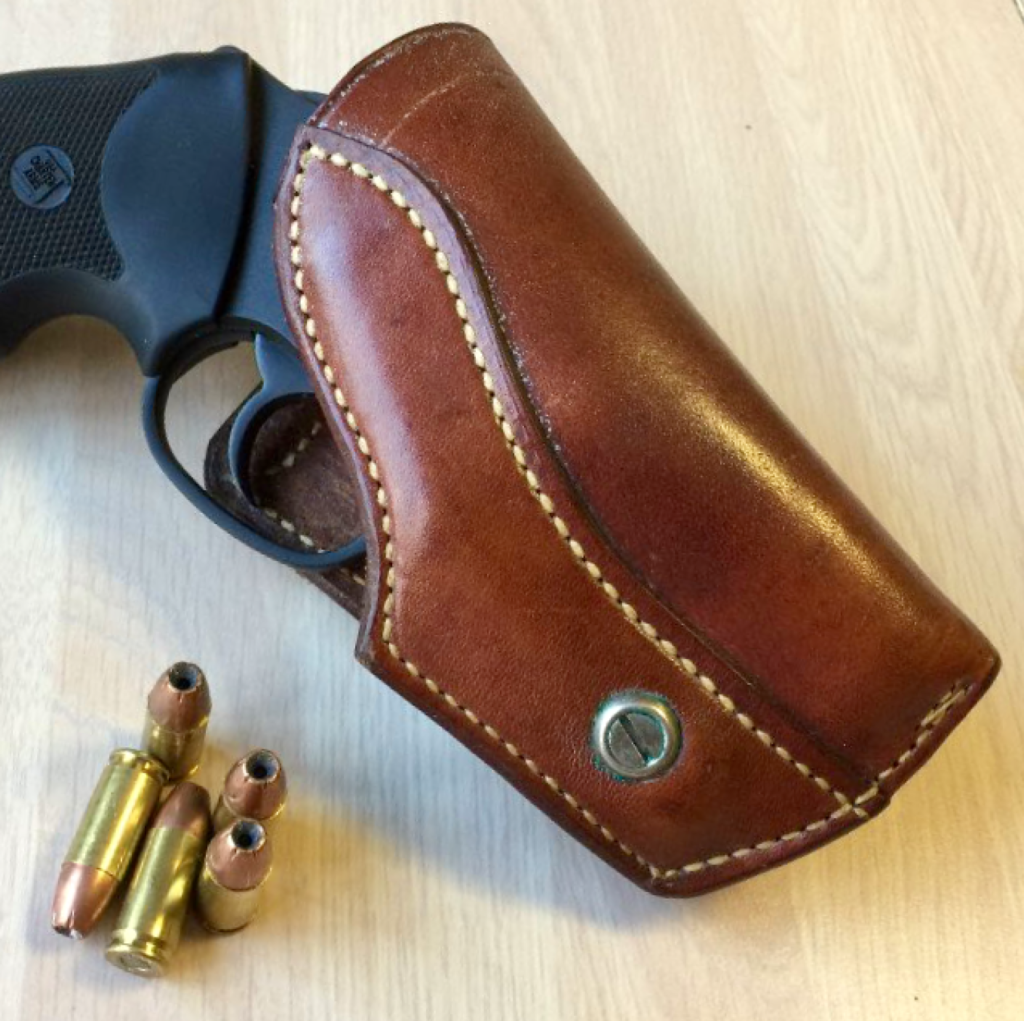
The price for this Charter Arms Pitbull is listed at $522 (www.charterfirearms.com) . Current pricing at Bud’s Gun Shop is $446. If you’ve already got a 9mm pistol and you want a revolver to go with it because you’re a RevolverGuy, the Charter Arms Pitbull is a reliable handgun that does the job snub nose revolvers are supposed to do.

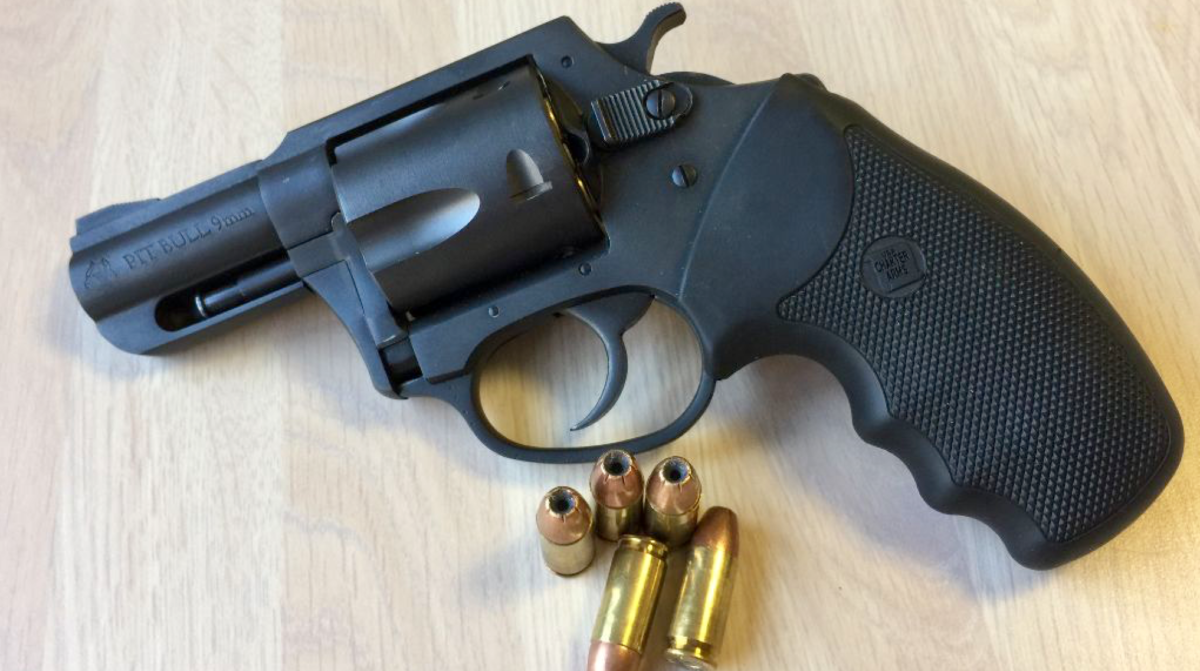
Interesting picture. I did not realize the extractor star was that thick on the Pitbull.
I had a Charter, your basic Undercover .38, earlier this decade (two actually, after CA replaced it). Too many times back for broken transfer bars.
It is rather thick isn’t it Lee?
Busted transfer bars? That should not happen, obviously. I’ve had limited experience with Charter Arms guns over the years, but I don’t have any first hand knowledge of problems from the owners I’ve talked to. A fireman friend’s father was a police officer. As he aged and some memory loss set in, he misplaced the cylinder from his .44 Bulldog. He used to separate the cylinder from the frame when he left home on vacation since he didn’t have a gun safe (he was in his 80s). My fireman friend could not find the cylinder after his father passed away. I told him to contact Charter Arms and see what they said. He called the company and gave the serial number. They shipped him a new cylinder for a very minimal charge and it dropped right in and worked fine. My friend was astounded with the customer service.
I really appreciated this review. I have seen other stuff on the Pitbull before but most of it wasn’t very balanced. People loved or hated the gun based on their opinion of Charter Arms and not the performance of the Pitbull itself. All too often we let the quest for perfection get in the way of using something that is good enough, or we excuse too much because of price. I felt that this review managed to avoid either of those pitfalls.
My only complaint with this review is that it just didn’t feel like Justin’s normal writing. Of course, when I got to the sentence about starting your police career in 1988, I realized that this was written by Mike, and just posted under Justin’s name (unless Justin has been holding out on info regarding his time as a pre-teen officer).
The target you showed looks fine, but I’m curious if you experienced any key-holing. My Charter Arms Pathfinder Lite (.22 Magnum) does keyhole a bit, and others have had similar experiences, but I have long suspected it had more to do with the .22 Magnum round than the shallow Charter Arms rifling that usually gets blamed.
Guys – my bad. Steve wrote this article and I posted it. Apparently I neglected to update the author. My mistake – should be fixed now.
You’re right Greyson, we to let the quest of perfection get in the way of using something that is good enough. Korth, Manurhin, Freedom Arms!
No problems with keyholing with the 9mm rounds.
I am leery of Charter Arms from many bad stories, but this snub is unique. It is just a bit too pricey when I could find a 9mm, using moon clips of course, from a maker I trusted more. Then again, a Taurus 85 has served me well for 20 years, and I bought it used.
Now at $250? I might snag one.
Old-School, what’s up with the price of revolvers today anyway? I agree with you that this one in Blacknitride+(TM) sure isn’t “cheap.” I’d snag one for $250 too!
Reading reports on recent guns shows that CA is making better quality stuff. When they were under the prior ownership, as Charco, quality took a dive.
I would take a chance on this gun in .45 auto, but it would have to be a $300 Gun. Otherwise I would just save up for something I want more.
As for why revolvers cost more than they once did, I leave that up to pros to tell us. More machining and fitting than on plastic fantastics?
“…More machining and fitting than on plastic fantastics?”
Some of that, but also, let’s face it – revolvers are becoming a niche market. If you aren’t going to make your money on volume, you need to make it on higher prices.
I agree for larger revolvers, though snubbies for carry seem alive and well as a mainstream gun. Some are really cheap. Conversely, the plastic fantastics I would buy, such as an M&P 2.0 in .45 auto or Walther PPQ in .45, ain’t dirt cheap, either. They tend to be bigger guns. I did like the Shield, however, even in .45!
I don’t like how snubs get marketed to ladies because of the simplicity of operation (as if women cannot figure out a semi), but that’s a different issue. The real reason for me, when it comes to choosing a revolver as a pocket gun is the contact shot.
I don’t disagree that snubbies are alive and well, but I’d bet there are scores of semiautos sold in the US for every one revolver sold. Glock alone probably accounts for more sales than revolvers.
I’ve seen some sub-$300 distributor prices on S&W 642s this year that left me shocked. I know the street prices will be higher, but that’s dirt cheap for a J-Frame. The other manufacturers would have a hard time competing on price at that amount.
I was persuaded to buy a bulldog by a gun shop guy who told me this new version of the company made “perfectly good guns.” It fired two 210 grain Black Hills LRN cowboy loads and locked up. That’s two rounds. I’m aware that they will fix it under warranty but that’s not much consolation if you have one when things go bump in the night.
Riley, did you send it back and did it get fixed? Would certainly be interesting to know what was wrong with it. Sure goes to show that test firing is mandatory with any gun, doesn’t it? There were three Detectives at my department who went out at lunch and bought S&W Bodyguard .380 pistols. I saw them in the station and they said, “Hey! We all bought the little laser Smith and Wessons!” I asked, “Where are they? (Assuming they were all in their boxes in the Detective office)” “The first Detective reached in his front pants pocket and said, “Right here. We bought those Nemesis holsters for them too.” The gun were loaded. Not cleaned, not oiled, not test fired, not qualified on the range. Just loaded and carried. WHAAAAAT? I set them straight. I can use your story of the first two rounds mucking up the gun as proof tale!
I’m going to at some point, but I’m still too frustrated to go through the process. Back burner thing, as I just won’t trust it anyway.
Charter customer service is very easy to deal with.
I bought a used Charter Arms 2000 used in .44 Special. I love .44 Special and until I got my Model 21 Thunder Ranch I shot the Bulldog alot and it has run like a champ.
Adam, you’re another one of the many .44 Bulldog owners I’ve heard from who love their Charter Arms revolver!
Steve, since we’re drifting into .44 Special territory, would it be fair to say Charter Arms had a fair hand in keeping that venerable cartridge breathing?
Absolutely! There was a time when the Bulldog was the only .44 Special available new. It’s amazing how many there are now. What would Skeeter Skelton say, right?
I’d really like to try one of these in .45acp. Been carrying an inherited .38 Undercover as a BUG for several years. Definitely not a range gun; too much fun. But it normally gets five or ten rounds fired for the annual carry-ammo-replacement gig, and it works. The Plus-P is pretty stout for my older hands, so I’m wondering if .45 might not be too much fun for the gun. I’d like to test-fire one before buying; but then again, I have a stock of good .45 ammo that my 1911 doesn’t care for, so having a revolver to use it in would be quite practical–if I could convince Momma. Sometimes her reasoning doesn’t work like mine does. She even made me sell a box of holsters in a garage sale once, instead of letting me buy guns to fit them. Ace
Ha! Ace, my dear wife doesn’t understand it either. I once bought an N-Frame because I already had the holster for it. I thought it made perfect sense. I suppose I should reconsider buying that case of .327 Federal Magnum before I get the gun . . .
Just a story about CA quality and service.
I bought a CA Bulldog for CCW last January. $380 in CA, that’s a decent deal. It locked up 20 rounds into the 50rd CCW qualification class. The cylinder bolt (which is actually a screw), came loose so the cylinder won’t open. Luckily I can also open it by pulling forward on the ejector rod so I was able to make safe and clear and didn’t get kicked out of the range.
That same day I shot an email to CA and they sent me a label. I explained to their nice CS rep Donna that this is a CCW gun and I need to be able to trust it completely. She told me that it will not happen again. Got the gun back after a week. I bobbed the hammer, trimmed the grips vertically and put 100 rds through it before trying the course again which I passed. I have since put another 100rds through it, including handloads, without incident so I think I’m good to go. With my grip mod it is only very slightly larger than a J frame while throwing a big bullet. I carry Doubletap 180gr JHP in it.
I have the magpug, and shot 38, 38 plus, 357 and very hot 357…probably have 1000 rounds throughout it. Trigger is butter and only issue, Remington box, three squib loads in a row…yes, i practice with light target 38s for drills didnt notice.. one first pull, I thought it was weak and next two bad…after I saw what happened.. gun since been cleaned..no questions called Donna fixed in 6 days no issues. I enjoy this .gun.. charter arms magpug is my rotation of conceal carry..no fears, the ammo is my worry… I am looking at CA 9mm, 40, 45, 45lc and 380. ..9mm article was selling point
For my concealed carry back up, Where can I buy a used CA 9mm,Pitbull? Double action, no hammer black, nitrite finish. Will need flex rubberized flat reload, and holster,belly and ankle. Thanks great article.